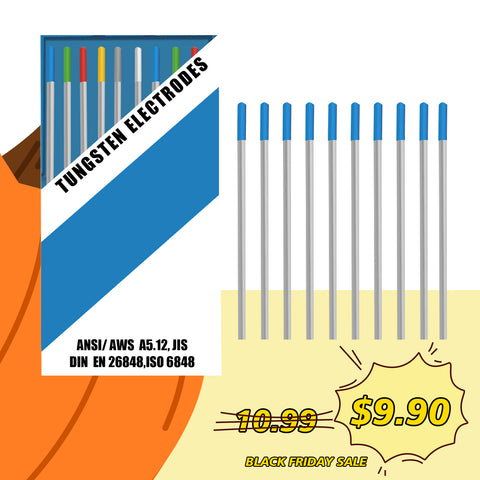Key Consumables in TIG Welding
Nov 23, 2023
Introduction
In the realm of welding precision and finesse, TIG welding stands as a paragon. Within its meticulous process lies a crucial factor often overshadowed—the consumables. This article delves into the intricacies of TIG welding consumables, unraveling their significance in achieving impeccable welds.
Understanding TIG Welding
TIG welding, or Tungsten Inert Gas welding, epitomizes precision. Unlike its counterparts, it employs a non-consumable tungsten electrode, offering unparalleled control over the arc. Comparing it with other methods, TIG welding emerges as the virtuoso, showcasing its prowess in diverse industries, from aerospace to delicate artistic creations.
| Cooled by: | TIG Torch | Ceramic Cup (Nozzle) Thread | Collet Body to Torch Thread | |||
| Type1 | Group | Standard | Stubby | |||
| Air | WP-17 | A | 13/32″ UNS | 3/4″ UNF | 3/8″ UNF | |
| Air | WP-26 | |||||
| Water | WP-18 | |||||
| Air | WP-9 | B | 3/8″ UNF | 9/16″ UNF | 5/16″ UNF | |
| Water | WP-20 | |||||
Essential Consumables
*Tungsten Electrodes

The selection of tungsten electrodes isn't a mere aesthetic choice; it's a strategic decision based on the materials being welded. When dealing with non-ferrous metals, ceriated tungsten steps into the limelight, offering superior arc stability. Lanthanated tungsten, on the other hand, exhibits prowess in both AC and DC welding setups, proving versatile for various applications.
Proper sharpening of tungsten electrodes is a ritual that transcends craftsmanship. A pointed electrode, achieved through careful grinding, allows for a more focused arc, enhancing precision in the welding process. This sharpening dance, an artistry of finesse, is imperative for maintaining the integrity of the electrode's tip.
*Shielding Gas
Shielding gas, the silent guardian of TIG welding, plays a pivotal role in maintaining the purity and stability of the welding arc. Argon, the noble gas, stands as the stalwart choice, offering a protective shield against atmospheric contaminants. Its inert nature ensures it doesn't react with the molten metal, preserving the integrity of the weld.
Commonly used shielding gases extend beyond argon, delving into the realms of helium. The helium-argon mix, a delicate ballet of gases, is often employed for welding materials with high thermal conductivity, enhancing arc penetration and overall welding efficiency.
Gas selection in TIG welding becomes a nuanced decision, intricately tied to the material and application at hand. When welding reactive metals like titanium, a pure argon shield proves its mettle, preventing unwanted reactions. Conversely, for non-ferrous metals, the argon-helium dance ensures a stable arc and impeccable weld quality.
In the realm of TIG welding, these consumables are not mere tools; they are the artisans that sculpt precision. The tungsten electrodes, filler metals, and shielding gases, each contributing its unique essence to the welding symphony, collectively elevate TIG welding from a craft to an art form. As the torch ignites and the arc dances, it's the consumables that truly shine, orchestrating a weld that transcends the mundane into the realm of excellence.
*Torch Body and Its Features

Features like a flexible neck or an articulated pivot point add a virtuoso touch, granting welders the ability to navigate tight spaces with ease. The torch body is not merely an instrument; it is a conduit for the welder's skill to manifest with precision.
*Collet Bodies and Collets
Enter the realm of *collet bodies and collets*, the hands that delicately cradle the tungsten electrode. These components embody precision, ensuring the electrode remains steadfast in its position. The collet body, threaded with finesse, secures the tungsten electrode in place, resisting the tumultuous forces of the welding arc.
*Gas Lens
The *gas lens*, a guardian of gas distribution, emerges as a crucial custodian of weld purity. Crafted with a meticulous array of fine mesh screens, it diffuses shielding gas evenly, enveloping the welding arc in a protective cocoon. This ensures that atmospheric contaminants are thwarted, allowing the weld to unfold in an environment of immaculate purity.
The gas lens doesn't merely disperse gas; it engineers a microcosm where the welding arc thrives. Its importance is akin to a filter in a symphony hall, ensuring that only the purest notes resonate. The welding arc, cradled within this gas lens sanctuary, performs with unrivaled stability and clarity.
Nozzles

Material considerations, often ceramic or other high-temperature alloys, ensure nozzles withstand the fiery ballet of the welding process. The shape of the nozzle, whether conical or cylindrical, directs the gas flow, affecting the width and intensity of the arc. Nozzles, in their simplicity, hold the power to transform a weld, turning it from a mere fusion of metals into a work of metallurgical artistry.
In the symphony of TIG welding torch components, the torch body, collet bodies, gas lens, and nozzles are not mere accessories; they are the virtuosos that elevate the welding experience. Each component, meticulously designed and harmonized, contributes to the precision and finesse that defines TIG welding as an art form. As the torch ignites, it is these consumables that take center stage, conducting a welding symphony that resonates with mastery and perfection.








